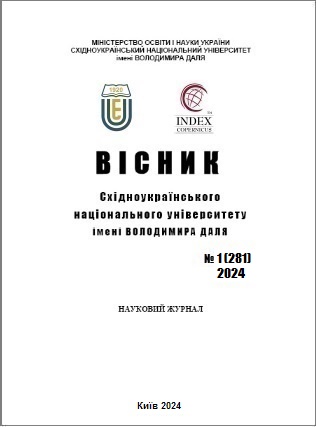Problems of choosing methods for evaluating fixed assets of an enterprise based on the materiality criterion
DOI:
https://doi.org/10.33216/1998-7927-2024-281-1-35-41Keywords:
fixed assets, accounting, valuation methods, variability, management decision, materiality criterionAbstract
Business operations with fixed assets significantly affect the structure of the balance sheet, income, expenses, profit and assessment of the financial condition of the enterprise.Their reflection in the financial statements is based on an accounting valuation. But such an assessment in legislative acts in most cases has a variable component. The availability of alternative parameters and valuation methods, on the one hand, provides additional tools for managing fixed assets. On the other hand, it requires economic justification. The purpose of the article is to develop recommendations for improving the methodological support for the management of fixed assets of the enterprise. The article examines the regulatory framework governing accounting in Ukraine.The results of the study indicate that one of the main criteria for choosing one of the options for the method of evaluating accounting objects is the principle of relevance. In most cases, you also need to select the materiality threshold. The article systematizes qualitative and quantitative indicators of materiality for choosing the assessment of fixed assets at revalued cost, which are recommended by law and scientists. The advantages and disadvantages of revaluation of non-current assets for domestic enterprises are considered. The influence of this valuation method on relevant items of financial statements of a production commercial enterprise is studied.This acts as an information basis for managing the company's fixed assets. It is determined that usually the specifics of enterprises' activities require simultaneous selection of several objects of variability in the assessment of fixed assets. The paper develops an algorithm for selecting materiality thresholds for evaluating fixed assets.For its application, CVP analysis tools are proposed, namely sensitivity coefficients and threshold values of the materiality coefficient. Applying the algorithm in practice will speed up, simplify and provide clarity to the analytical stage of the management decision-making process regarding the choice of variable methods for evaluating fixed assets. This allows you to ensure the target level of key performance indicators in accordance with the strategic goal of the enterprise.
References
1. Задорожний З-М, Муравський В., Костецький Я. Удосконалення обліку необоротних активів у системі ефективного управління ними. Фінансово-кредитна діяльність: проблеми теорії та практики. 2022. №46. Том 5. С. 149-160.
2. Даценко Г.В., Кудирко О.М., Лобачева І.Ф. Особливості обліку та внутрішнього контролю операцій з основними засобами підприємства. Таврійський науковий вісник. 2023. Випуск 15. URL: http://tnv-econom.ksauniv.ks.ua/index.php/journal/article/view/351 (дата звернення 22.01.2024).
3. Фрайман А.В. Селіванова Н.М. Удосконалення організації обліку основних засобів в період карантину.Економіка: реалії часу. 2022. № 2 (60). С. 68-81.
4. Озерова О. Майно юрособи забрали на потребу оборони: що з обліком та податками. Електронний журнал: Головбух. 2022. №10. URL: https://egolovbuh.mcfr.ua/960396 (дата звернення 22.01.2024).
5. Салова Н. «Відчуження», «вилучення», «добровільна передача» — у чому різниця? ЛІГА : ЗАКОН. 2022. URL: https://buh.ligazakon.net/aktualno/11939_peredacha-transportnikh-zasobv-dlya-potreb-arm-u-perod-vonnogo-stanu-yuridichn-aspekti-dokumentuvannya-ta-oblk (дата звернення 22.01.2024).
6. Савків У.С., Василюк М.М., Лещук Г.В. Модель комплексного аналізу основних засобів у системі управління підприємством. Актуальні проблеми розвитку економіки регіону. 2023. Випуск 19. Т. 1. С. 177-184.
7. Перетятько Ю. Дотримання суттєвості у фінансовій звітності: теоретичні та практичні аспекти. Сучасна економіка. 2020. № 24. С. 138-142.
8. Колєсніченко А.С. Використання поняття істотності в обліку, звітності, аудиті та оподаткуванні. Проблеми системного підходу в економіці. 2019. № 74. Випуск 6.URL:http://psae-jrnl.nau.in.ua/journal/6_74_3_2019_ukr/16.pdf. (дата звернення 22.01.2024).
9. Карпова В. Переоцінка основних засобів під час воєнного стану: коли її проводити і як це робити. Все про бухгалтерський облік. 2022. № 39. С. 19-28.
10. Васил’єва Ю. Переоцінка основних засобів 2023. Електронний журнал:Факторія. 2023. URL:https://faktoria.kiev.ua/uk/pereocinka-osnovnih-zasobiv/(дата звернення 22.01.2024).
11. Національне положення (стандарт) бухгалтерського обліку 1 «Загальні вимоги до фінансової звітності» : наказ Міністерства фінансів України від 07.02.2013 р. № 73. URL:https://zakon.rada.gov.ua/laws/show/z0336-13#Text (дата звернення 22.01.2024).
12. Про затвердження Методичних рекомендацій щодо облікової політики підприємства : наказ Міністерства фінансів України від 27.06.2013 р. № 635. URL:https://zakon.rada.gov.ua/rada/show/v0635201-13#Text (дата звернення 22.01.2024).
13. Щодо суттєвості у бухгалтерському обліку і звітності : лист Міністерства фінансів України від 29.07.2003 р. № 04230-108. URL: https://zakon.rada.gov.ua/rada/show/v4108201-03#Text (дата звернення 22.01.2024).
14. Положення (стандарт) бухгалтерського обліку 7 «Основні засоби» : наказ Міністерства фінансів України від 27.04.2000 р. № 92.URL: http://zakon.rada.gov.ua/laws/show/z0288-00(дата звернення 22.01.2024).
15. Положення (стандарт) бухгалтерського обліку 15 «Дохід» : наказ Міністерства фінансів України від 29.11.99 р. № 290. URL:https://zakon.rada.gov.ua/laws/show/z0860-99#Text(дата звернення 22.01.2024).
16. Положення (стандарт) бухгалтерського обліку 16 «Витрати» : : наказ Міністерства фінансів України від31.12.99 р. №318. URL:https://zakon.rada.gov.ua/laws/show/z0027-00#Text(дата звернення 22.01.2024).
17. Про затвердження Методичних рекомендацій з бухгалтерського обліку основних засобів : наказ Міністерства фінансів України від 30.09.2003 р. № 561.URL: https://zakon.rada.gov.ua/rada/show/v0561201-03#Text (дата звернення 22.01.2024).
18. Про затвердження Методичних рекомендацій щодо заповнення форм фінансової звітності : наказ Міністерства фінансів України від 28.03.2013 № 433. URL: https://zakon.rada.gov.ua/rada/show/v0433201-13#Text (дата звернення 22.01.2024).

